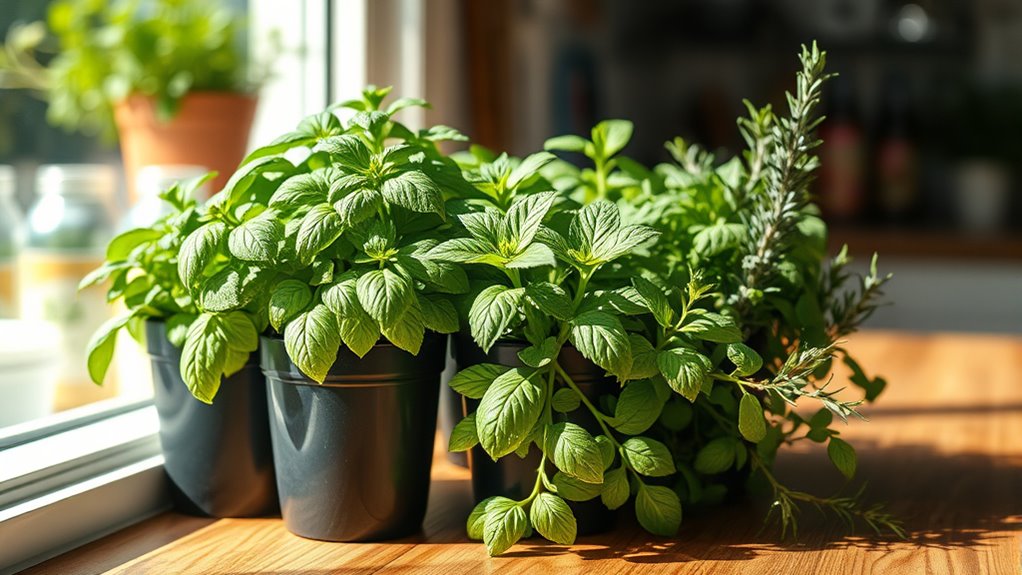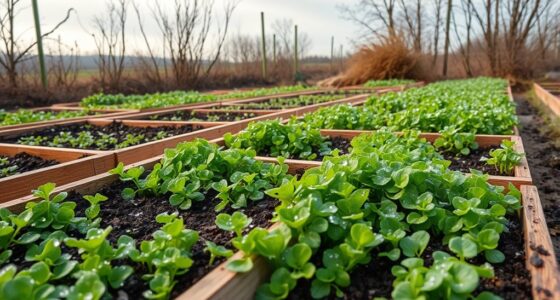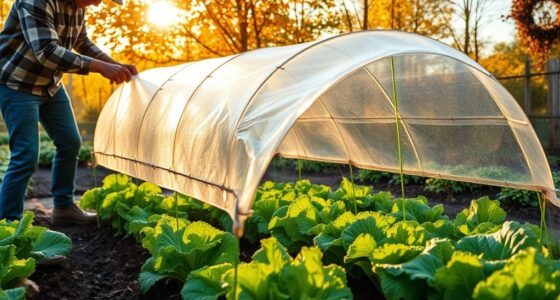To grow herbs indoors year-round, pick varieties like basil, chives, and mint that thrive in pots. Place them in east or west-facing windows for 4-6 hours of sunlight daily, and make sure temperatures stay between 50°F to 60°F at night. Use deep containers with good drainage and organic potting mix. Water properly, allowing the top soil to dry out slightly, and regularly trim your herbs for fuller growth. There's so much more to explore!
Key Takeaways
- Choose resilient herbs like basil, chives, and thyme for indoor growth, grouping those with similar light and water needs for easier maintenance.
- Ensure your herbs receive 4-6 hours of sunlight daily from east or west-facing windows, using grow lights if necessary.
- Use deep, wide containers with good drainage and organic potting mix to support healthy root systems and prevent overwatering.
- Water herbs carefully, allowing the top 1-2 inches of soil to dry out between waterings to avoid root rot and fungal issues.
- Regularly prune and harvest your herbs to encourage bushier growth and enhance flavor throughout the year.
Selecting the Right Herbs for Indoor Growth

When it comes to selecting the right herbs for indoor growth, you'll want to focus on a few key varieties that thrive in confined spaces. Basil, chives, oregano, thyme, and mint are excellent choices for indoor herbs, as they adapt well to indoor conditions.
It's beneficial to group herbs with similar light and water requirements together, simplifying maintenance. Consider using deep and wide containers to accommodate their root systems and prevent overwatering issues.
Woody herbs like thyme are particularly resilient and can flourish indoors with proper care. To promote bushier growth and enhance flavor, remember to regularly harvest your herbs; cutting them back won't harm their health, and it encourages a fuller, more vibrant plant.
Understanding Light and Temperature Needs
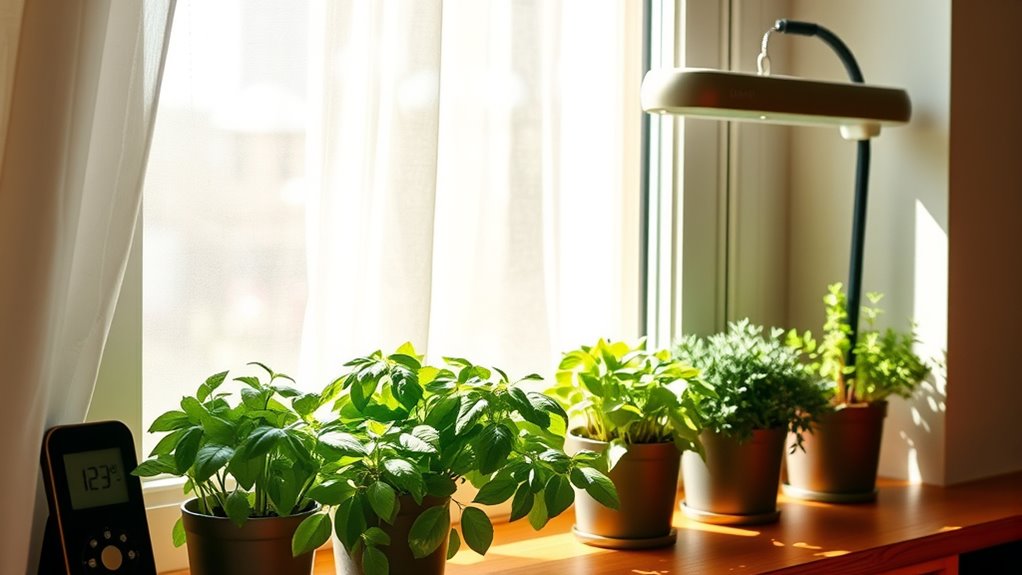
To guarantee your indoor herbs thrive, it's important to understand their light and temperature needs. Most herbs prefer temperatures between 50°F to 60°F at night, promoting compact growth and keeping pests at bay. For sunlight, position your herbs in an east-facing or west-facing window for ideal exposure. Make sure they receive a minimum of 4-6 hours of sunlight daily; leggy growth signals insufficient light.
| Light Source | Temperature Range |
|---|---|
| East-facing window | 50°F to 60°F |
| West-facing window | 50°F to 60°F |
| Artificial grow lights | Supplemental use |
| Insufficient light | Leads to leggy growth |
Choosing the Perfect Containers and Soil
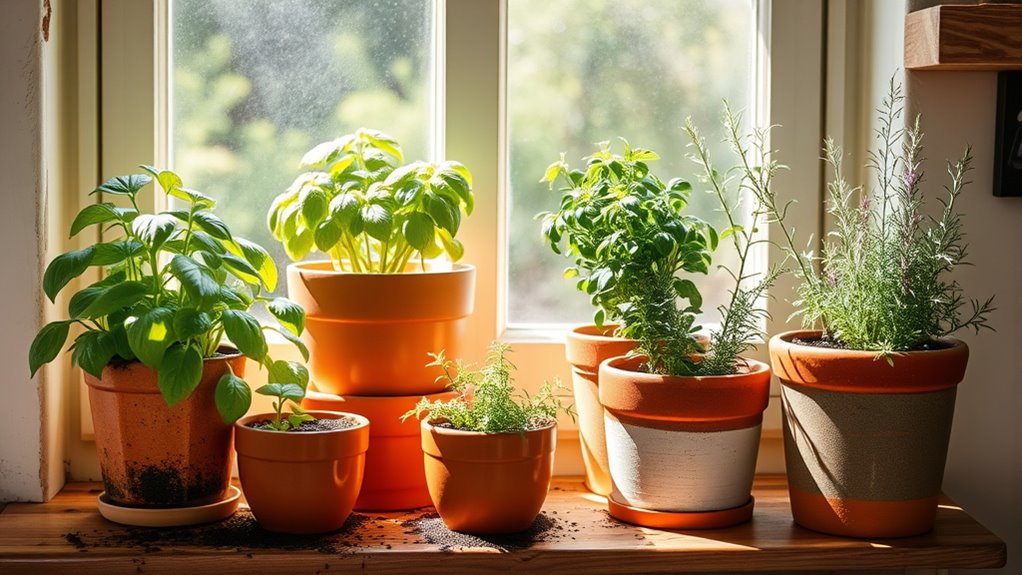
How can you guarantee your indoor herbs flourish? Start by choosing the right containers. Opt for deep and wide pots that fit your herbs' root systems, ideally around 6 inches deep.
Make sure your containers have good drainage holes to prevent water accumulation, which can cause root rot. Next, select an organic potting mix enriched with compost, as it provides essential nutrients for healthy growth.
Ensure proper drainage in your containers to avoid root rot, and choose an organic potting mix enriched with compost for optimal growth.
Avoid over-potting; your herbs shouldn't "swim" in their soil. If you're growing multiple varieties, consider larger containers to help retain moisture better than individual pots.
With the right containers and soil, your indoor herbs will thrive, offering you fresh flavor all year round.
Essential Watering Practices for Herbs
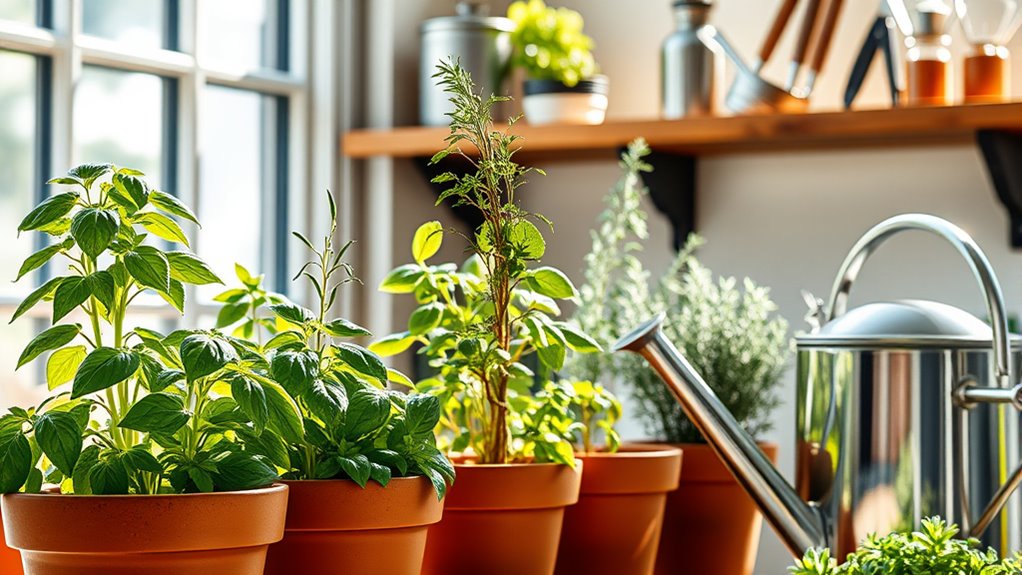
Proper watering is essential for your indoor herbs' success. Most herbs prefer the top 1-2 inches of soil to dry out slightly between waterings, so check for dryness before you water again.
Overwatering can lead to root rot and fungus, so make certain your pots have good drainage and never let them sit in standing water. When you water, aim for the base of the plant to keep the leaves dry and reduce the risk of fungal diseases.
During winter months, with lower light levels, reduce your watering frequency since herbs need less moisture in cooler conditions.
Bottom watering can also be effective; just place the pot in a basin of water and let it absorb moisture through the drainage holes. Additionally, understanding the importance of essential survival gear can help you create a more resilient indoor gardening setup.
Harvesting Techniques for Flavor Enhancement
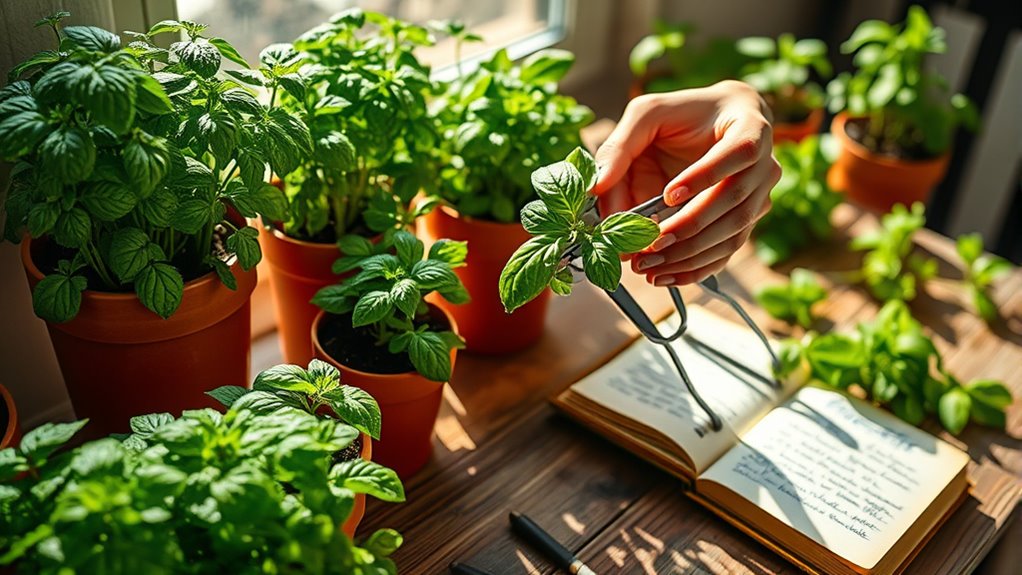
To enhance the flavor of your indoor herbs, regularly clip the outer branches to encourage new growth.
Timing your harvest is key; aim to pick your herbs in the morning when their essential oils are most potent.
Regular Clipping Benefits
Clipping your herbs regularly not only enhances their flavor but also promotes healthier growth. By practicing regular clipping, you encourage branching, which boosts flavor production and leads to a more vibrant taste in your dishes.
Aim to harvest about one-third of your herb plant at a time; this method guarantees a continuous supply of fresh leaves without stressing the plant. Frequent pruning fosters fuller growth, giving you a bushier herb plant that thrives throughout the growing season.
Always use clean scissors to clip your herbs, as this helps prevent disease and keeps your plants healthy. With regular harvesting, you can enjoy seamless indoor growing and shift your herbs outdoors for seasonal enjoyment of fresh flavors.
Timing for Optimal Flavor
When you want to elevate the flavor of your indoor herbs, timing your harvest is essential. Proper timing not only enhances their taste but also promotes healthy growth. Here are some tips for ideal flavor:
- Morning harvesting: Pick your herbs in the morning after the dew has dried. This preserves the essential oils that contribute to their flavor.
- Regular harvesting: Frequent clipping encourages bushier growth and more flavorful leaves. Aim to cut the outer branches and never remove more than one-third of the plant.
- Winter care: Keep harvesting during the winter months to support active growth and maintain a steady supply of fresh ingredients.
Maintenance Tips for Healthy Herb Growth
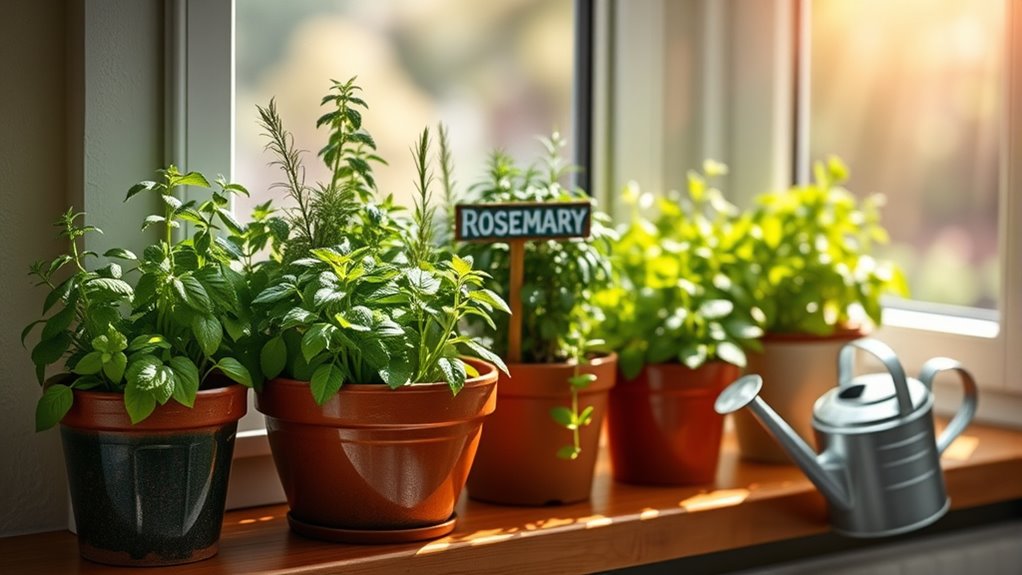
To keep your herbs thriving indoors, focus on watering, light, and pruning.
Make sure the top layer of soil dries out before adding more water, and position your plants near windows for ideal sunlight.
Regularly trim your herbs to encourage growth and enhance their flavor.
Optimal Watering Practices
Ideal watering practices are essential for maintaining healthy herb growth, as overwatering can lead to root rot and other issues. To guarantee your herbs thrive, follow these tips:
- Check soil moisture frequently; let the top 1-2 inches dry before watering. Most herbs prefer drier conditions.
- Use containers with good drainage holes to prevent standing water, which can attract fungus gnats or cause root rot.
- Consider bottom watering for even moisture distribution without oversaturating the soil surface.
Water herbs when the soil feels dry to the touch, typically every 1-2 weeks. Adjust your watering frequency based on the season and indoor climate.
Monitoring potting mix consistency will help you avoid overwatering, guaranteeing healthy root development in your container gardening.
Light Exposure Requirements
Watering practices set the stage for healthy herb growth, but light exposure plays an equally important role. Most indoor herbs need at least 4-6 hours of sunlight daily, so place them in a south- or west-facing window for ideal growth.
If you notice leggy growth or stunted leaves, your herbs aren't getting enough energy. Regularly rotate your pots every couple of days to guarantee even light distribution and prevent one side from becoming too leggy.
For herbs that tolerate partial sun, an east-facing window can suffice, but avoid north-facing windows altogether. If natural light is limited, consider using artificial grow lights to maintain the conditions necessary for healthy development during darker winter months.
Regular Pruning Techniques
While it may seem counterintuitive, regular pruning is essential for keeping your indoor herbs healthy and productive. By clipping the tops, you encourage bushier growth and more lateral branches.
Here are some tips to make the most of your pruning:
- Use clean scissors or pruners for precise cuts, preventing damage and disease.
- Aim to prune no more than one-third of the plant at a time to avoid stressing it.
- Regularly pinch back herbs when they reach a few inches tall to increase overall yield.
Frequent harvesting can also enhance flavor, making your herbs more aromatic and flavorful for cooking. Additionally, incorporating personal touches in your herb garden, such as using decorative pots or labeling, can add charm and make the space inviting.
With these regular pruning techniques, your indoor herb garden will thrive year-round.
Transitioning Herbs Outdoors in Warmer Months
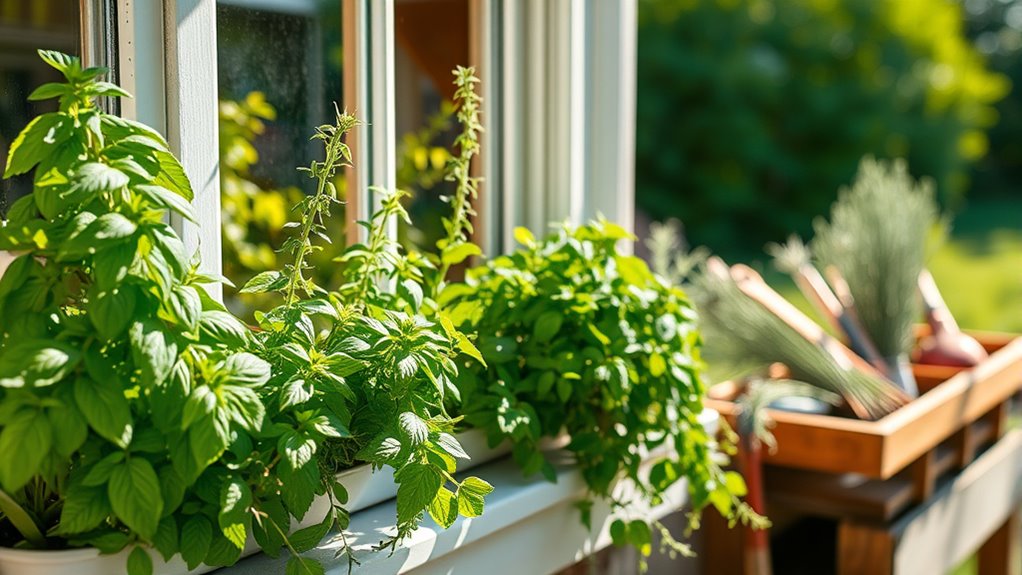
As temperatures rise and the days grow longer, altering your indoor herbs outdoors can enhance their growth and flavor. To successfully shift your herbs outdoors, remember to acclimate indoor herbs gradually. Start by exposing them to sunlight for a few hours each day over a week. Confirm nighttime temperatures are above 50°F to 60°F, and choose a sunny spot that gets 4-6 hours of sunlight daily to promote healthy growth and prevent leggy plants. Don't forget to water herbs adequately before moving them outside and monitor moisture levels closely, as outdoor conditions can dry soil quickly. Here's a handy table to guide you through the process:
| Step | Action | Notes |
|---|---|---|
| Acclimate | Gradually increase sunlight | Avoid shock |
| Check temperatures | Above 50°F to 60°F | Essential for growth |
| Choose location | 4-6 hours of sunlight | Prevent leggy plants |
| Water herbs | Before moving outside | Maintain moisture levels |
| Inspect for pests | Before bringing indoors | Prevent infestations |
Recommended Tools and Resources for Indoor Gardening
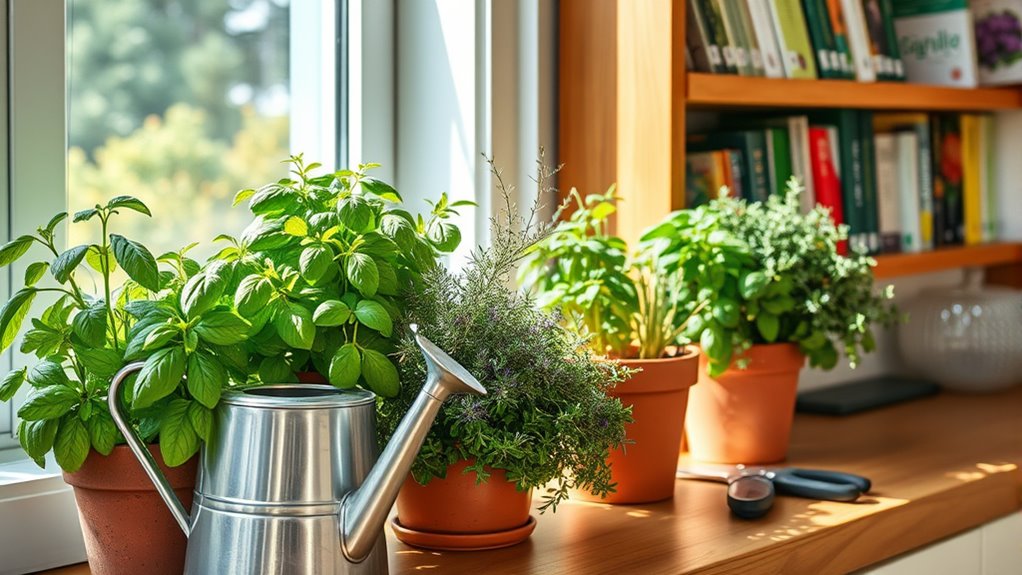
Once your herbs are thriving outdoors, it's important to equip yourself with the right tools and resources for indoor gardening.
Investing in high-quality tools and materials guarantees your indoor herbs flourish. Here are some essentials to contemplate:
- Deep 72 Cell Seedling Trays: Perfect for starting herb seeds and promoting root development.
- Organic Potting Mix: Choose a well-draining mix enriched with compost for healthy growth.
- Grow Lights: Use these during winter months to provide 4-6 hours of sunlight daily, essential for your herbs.
Don't forget to keep a weatherproof log book to track your activities, including planting dates and growth progress. Incorporating self-watering planters can also help maintain consistent moisture levels for your indoor herbs.
With these tools, you'll enjoy fresh herbs year-round!
Frequently Asked Questions
How to Have Fresh Herbs Year Round?
To have fresh herbs year-round, start by selecting varieties that thrive indoors, like chives, thyme, and mint.
You'll want to place them in east- or west-facing windows, ensuring they get 4-6 hours of sunlight daily.
Use deep containers with well-draining potting mix and monitor soil moisture closely.
Regularly trim your herbs to encourage fuller growth and flavor, and remember to let the top layer of soil dry out before watering.
Enjoy your fresh herbs!
How Do You Keep Herb Plants Alive Indoors?
To keep your herb plants thriving indoors, start by selecting sunny spots, ensuring they soak up sufficient sunlight.
Stick to spacious, sturdy pots with proper drainage to support healthy roots.
Stay savvy about soil moisture; let the top layer dry out before watering.
Snip and savor your herbs regularly to boost growth and flavor.
Finally, don't drown them in fertilizer during winter's waning light—less is often more!
Enjoy your indoor herb haven!
How Do You Store Fresh Herbs for a Long Time?
To store fresh herbs for a long time, wrap them in a damp paper towel and place them in a sealed plastic bag in the fridge.
For longer storage, puree herbs like basil or parsley with olive oil and freeze them in ice cube trays.
You can also dry herbs by hanging them upside down in a dark, ventilated area or store them in a glass of water, covered loosely with plastic.
What Is the Best Fertilizer for Indoor Herbs?
When you're choosing the best fertilizer for indoor herbs, consider balanced options like a water-soluble fertilizer with an NPK ratio of around 10-10-10.
You'll want to dilute it to half-strength, preventing over-fertilization. Alternatively, mix compost into your potting soil for natural enrichment.
Pay attention to your plants; if they look leggy or pale, it's time to fertilize, while vibrant growth indicates they're getting enough nutrients.
Keep your herbs thriving!
Conclusion
By now, you've gathered the essential tips to grow vibrant herbs indoors, but the real magic happens when you take that first taste of your fresh basil or mint. Imagine the burst of flavor in your dishes—it's just a snip away! Keep nurturing your green companions through the seasons, and don't rush to move them outside just yet; there's a surprise waiting for you in your kitchen garden. What will you create next?

